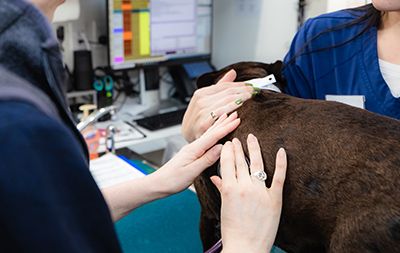Canine Medical Imaging, Ultrasound, X-rays, Radiographs
Veterinary diagnostic imaging refers to various non-invasive methods of taking medical images of an animal’s internal body. The purpose is to diagnose various health conditions. At La Jolla Veterinary Hospital, we have the most advanced medical imaging tools. The technologies are the same caliber as those in modern human hospitals.
Veterinary Diagnostic Imaging
Veterinary diagnostic imaging is essential for diagnosing, managing, and treating many conditions in animals. It allows veterinarians to collect information about an animal’s health.
Most imaging tools used in veterinary medicine are entirely painless and non-invasive. Some procedures may need anesthesia or sedation to keep the patient still. Veterinarians use the images produced to collect information on their animal patients. That information helps them make informed medical and surgical plans.
Our veterinary diagnostic imaging team comprises board-certified veterinarians, radiation technologists, and other medical professionals. We strive to offer excellence in veterinary care to our highly-valued patients.
When Is Canine Medical Imaging Necessary?
Sometimes, veterinarians need to see the internal workings of their patients’ bodies to make an accurate diagnosis and prognosis. They rely on veterinary imaging tools to do that. Are you familiar with CT scans, X-rays, and ultrasounds? These technologies allow us to see inside your canine companion’s body. The images will give us a more comprehensive picture of your dog’s health.
A typical dog wellness checkup involves a vet checking your dog’s overall health. Some tests performed during a wellness checkup include a simple dental exam, eye exam, and listening to the dog’s heartbeat. There is only so much a veterinarian can tell from such tests. Veterinary diagnostic imaging answers any lingering questions about the internal workings of the canine patient.
Types of Canine Medical Imaging Technologies
Canine diagnostic imaging tools have one thing in common. They all provide images of different parts of a dog’s internal anatomy. These images help veterinarians make a more informed diagnosis of their patient’s health. Canine diagnostic imaging includes the following:
X-rays
Most people are familiar with X-rays, also called radiographs. They are the most common diagnostic tool in veterinary hospitals. The X-ray process is the same for dogs as it is for humans. The veterinarian will position your dog for the X-ray beam to take images of a specific area of the body.
X-rays are safe for dogs, and they can help diagnose various medical conditions. These include arthritis, broken bones, and foreign objects in a dog’s digestive tract. Your veterinarian may need to sedate your furry friend to calm them down before the procedure.
Ultrasounds
Another common canine diagnostic imaging tool is ultrasound. When veterinarians suspect a heart condition in dogs, they usually recommend an ultrasound. When showing details of internal organs and soft tissue, an ultrasound is better than a traditional X-ray.
At La Jolla Veterinary Hospital, we understand the importance of veterinary diagnostic imaging. We will use various imaging tools to determine what is ailing your dog.
For more on canine medical imaging, visit La Jolla Veterinary Hospital at our office in La Jolla, California. Call (858) 454-6155 today to schedule an appointment.








